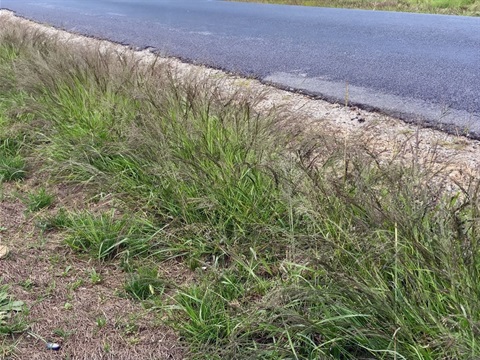
Across the Snowy Monaro in recent months, we have been seeing many species of lovegrass appearing on roadsides, along driveways and across paddocks. Lovegrasses are a genus of tropical grasses – known scientifically as Eragrostis – with around forty-five different species recorded in NSW. Many of these are native to Australia.
The wet and tropical-like summer this season has provided the ideal conditions for pastures to grow, including many of our local tropical pasture species. Whilst the tablelands may not be thought of as a good location for tropical grasses due to their cold winters, many species occur naturally or have been introduced over the years.
Lovegrasses are one of the more common kinds of tropical grass found in the Snowy Monaro. Most lovegrass species go unnoticed throughout the year until peak summer, when their seed heads make them highly visible.
Many lovegrass species on the tablelands are short-lived perennial or annual species that germinate during spring, do the bulk of their growth and reproduction during summer and die during autumn once frosts begin. These species include weeping lovegrass, soft lovegrass and stinkgrass. These annual species can provide some grazing value for animals during their short vegetative growth phase.
Brown’s lovegrass, rough-grain lovegrass and paddock lovegrass are all native perennial lovegrasses that die-back, but are not dead, during winter. These lovegrass species live for many years, and during spring and early summer they do provide grazing value for livestock in pasture.
The introduced and perennial-growing African lovegrass is the one lovegrass that is loathed by land managers far and wide. This highly invasive weed is rapidly spreading across both coastal and tablelands landscapes. African lovegrass not only lowers the productive capacity of agricultural land, but it also compromises biodiversity and poses a serious fire threat to the environment and those within it.
This summer has presented the perfect conditions for lovegrasses in general to flourish, but unfortunately, this has also meant we have seen an explosion of African lovegrass across the Snowy Monaro.
African lovegrass can go from germination to flowering within a matter of weeks under ideal conditions. This speed of growth makes it nearly impossible for even the most diligent and vigilant land managers to keep on top of African lovegrass on their properties, especially during a summer like the present season.
Many annual lovegrasses can be identified along much of our local road network, taking advantage of the seasonal conditions, but posing no real long-term issue.
Council is here to help if you have questions about lovegrass, weeds, or other biosecurity matters. If you’re a property owner or land manager, you can contact our specialist biosecurity officers for advice and assistance.








